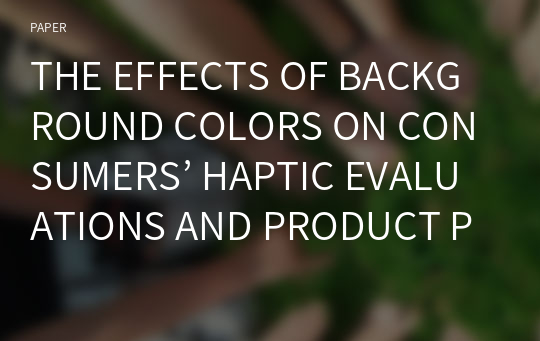THE EFFECTS OF BACKGROUND COLORS ON CONSUMERS’ HAPTIC EVALUATIONS AND PRODUCT PREFERENCES
* 본 문서는 배포용으로 복사 및 편집이 불가합니다.
서지정보
ㆍ발행기관 : 글로벌지식마케팅경영학회(GFMC)
ㆍ수록지정보 : Global Marketing Conference
ㆍ저자명 : Mayuko Nishii, Takeshi Moriguchi
ㆍ저자명 : Mayuko Nishii, Takeshi Moriguchi
영어 초록
IntroductionCan the background colors of products on an online shopping site affect consumers’ haptic perceptions and evaluations? When shopping online, consumers cannot obtain a product’s haptic information by touching it directly and usually rely on visual information such as the product’s image and description. Nevertheless, consumers sometimes use haptic information to judge whether to purchase a product and marketers aim to engage consumers’ haptic preferences. Currently, researchers in the field of sensory-marketing research are interested in the interaction of multiple senses. Although previous research has demonstrated the interaction between visuals and haptic perception (e.g. Xu & Labroo, 2014), there is still considerable opportunity for further research on consumers’ haptic perception of products they cannot touch directly, such as through online shopping. In this study, we focus on how the background colors of product images affect consumer’s haptic perceptions and evaluations of the products.
Theoretical Background
Krishna & Morrin (2008) indicate that the interaction among plural senses is caused by perceptual transfer. When an individual perceives a sense, it is associated with previous experiences with other senses, which may cause perceptual transfer (Piqueras-Fiszman & Spence, 2015). For instance, Harrar, Piqueras-Fiszman, & Spence (2011) found that the color of the bowl affected consumers’ perceptions of taste when eating popcorn. In this study, when consumers ate popcorn in a red bowl, they associated the color with mature fruit and evaluated the popcorn as sweeter. Consumers who ate popcorn from a blue bowl evaluated the popcorn saltier because they associated the color with the sea. Based on these results, we predict that the background colors of products will affect consumers’ haptic perceptions and product preferences. Babin, Hardesty, & Suter (2013) show that red and orange induce the perception of warmth. Thus, an orange background color causes consumers to perceive products as warmer. Zwebner, Lee, & Goldenberg (2014) demonstrate the influence of physical warmth on consumers’ behavior and they focus on the anthropomorphic characteristics of products. They mention that consumers tend to perceive inanimate products as anthropomorphized so when they percept warmth to products, they feel emotional warmth and it induces their intention to purchase them. From their findings, we predict that the effect of warm background colors is restricted to anthropomorphized products. Additionally, warmth is strongly associated with softness (Tai, Zheng, & Narayanan, 2011). Hence, we also predict that warm background color might affect consumers’ perception of softness of the products. H1: The color orange is perceived as warmer than white (control). H2a:When the background color is orange (vs. white), anthropomorphized products are evaluated with more familiarity. H2b: When the background color is orange (vs. white), anthropomorphized products are evaluated more favorably. H2c: When the background color is orange (vs. white), there is greater intention to purchase anthropomorphized products. H3a:When the background color is orange (vs. white), anthropomorphized products are perceived as warmer. H3b: When the background color is orange (vs. white), anthropomorphized products are perceived as softer. H4: The perception of the warmth of products affects the perception of softness of products. H5: The influence of “H2a” mediates the perception of warmth of products.
Methods
We conducted two studies to research the hypotheses above. Warm and soft inanimate products are anthropomorphized (Horowits & Bekoff, 2007), and we researched this hypothesis by comparing warm and soft products with cold and hard products in study1. For the purpose of identifying warm and soft products (anthropomorphized products) as well as cold and hard products (non-anthropomorphized products), we conducted a pretest. For the study1 pretest, we chose a teddy bear, futon, and scarf as anthropomorphized products and a garbage can, ice pop, and glass as non-anthropomorphized products. In study2, we used hand watches, which are considered cold and hard. However, a watch indicating 10:10 is recognized as a smiling human (Labroo, Dhar, & Schwarz, 2008). Hence, we compared watches set to 10:10 and 12:00. For study1 and study2, we conduct a 2 (orange vs. white) × 2 (anthropomorphized products vs. non-anthropomorphized products) between-subject test on the participants. Participants answered a questionnaire on a website. They evaluated the color and products on a 7-point Likert scale. For both study1 and study2, we recruited participants via the Internet. They received a point worth 3 JPY (approximately 0.03 USD) for participating in the study.
Results
Study1
We used a t-test to compare the averages of warmth to the background colors. It showed a significant difference between Group orange and white (t=32.329, df=916.938, p< .001). For H2a to H3b, we conducted the two-way ANOVA of 2 (background color: orange, white)×2(anthropomorphic characteristics of products: anthropomorphized, non-anthropomorphized). The results showed no interactions. Hence, we used t-tests (See Table1). The results supported H2a to H3b. In addition, we conducted a path analysis on the influence of the perception of products’ warmth toward the perception of products’ softness. The influence was significantly positive (β=0.776, p<.001). In comparison, the path from the background colors to the perception of products’ softness was not significant (p= .142). Hence, H4 was supported.
Study2
We used a t-test to compare the averages of warmth to the background colors. It showed a significantly positive difference between Groups orange and white (t=22.206, df=323.539, p< .001). Therefore, H1 was supported again. Aside from the above analysis, the results supported H2a to H3b (See Table2). Furthermore, to test H4, we conducted a path analysis on the influence of the perception of products’ warmth towards the perception of products’ softness. Results showed that the influence was significantly different (β=0.823, p<.001). In comparison, the path from the background colors to the perception of products’ softness was not significant (p= .142). Thus, H4 was supported again. Moreover, to test H5, we ran the mediation model by using the PROCESS macro (Model 4, Hayes, 2013). For anthropomorphized products, bootstrapping tests with 2,000 bootstrapped samples revealed that the effect of background colors on familiarity was mediated by the perception of the warmth of the products(a×b=0.09, 95%CI=0.058 to 0.478 excluded 0). The direct effect c’ (0.15) is significant (p= .045), although c (0.06) is not significant (p= .385). On the other hand, for non-anthropomorphized products, the regression analysis revealed that the direct effect c’ (-0.03) is not significant (p=0.711). Hence, H5 was supported.
Discussion and Conclusion
We demonstrated that warm background colors affect the perception of products’ warmth and softness and increase consumers’ intention to purchase products. We also found that the effect of warm background colors is restricted to anthropomorphized products. This research showed that the effect of warm background colors on the familiarity of anthropomorphized products was mediated by the perception of the products’ warmth. Based on these results, we also demonstrated that the perception of products’ warmth influenced the perception of their softness. Our findings might help to apply Zwebner et al. (2014)’s findings regarding online shopping sites where consumers cannot touch products directly and marketers cannot control consumers’ room temperature.
참고 자료
없음"Global Marketing Conference"의 다른 논문
 THE ROLES OF GREEN PACKAGING IN UGLY FOOD PURCHASE INTE..22페이지
THE ROLES OF GREEN PACKAGING IN UGLY FOOD PURCHASE INTE..22페이지 THE IMPACT OF INDUCED AWE ON ETHICAL TOURIST BEHAVIORS5페이지
THE IMPACT OF INDUCED AWE ON ETHICAL TOURIST BEHAVIORS5페이지 A BIBLIOMETRIC ANALYSIS OF SPIRITUAL TOURISM RESEARCH15페이지
A BIBLIOMETRIC ANALYSIS OF SPIRITUAL TOURISM RESEARCH15페이지 SOCIAL NETWORK ANALYSIS AND RESPONSE TIME TESTING: CONS..11페이지
SOCIAL NETWORK ANALYSIS AND RESPONSE TIME TESTING: CONS..11페이지 THE EFFECTS OF PARA-SOCIAL INTERACTION ON ONLINE CELEBR..3페이지
THE EFFECTS OF PARA-SOCIAL INTERACTION ON ONLINE CELEBR..3페이지 THE INFLUENCE OF OPINION LEADERS ON DAILY DEALS USER’S ..3페이지
THE INFLUENCE OF OPINION LEADERS ON DAILY DEALS USER’S ..3페이지 HOW IMMERSIVE RETAILING AFFECTS CONSUMERS’ URGE TO BUY:..6페이지
HOW IMMERSIVE RETAILING AFFECTS CONSUMERS’ URGE TO BUY:..6페이지 KEY TO SUPERSTARDOM IN A GLOBALISED MARKET: THE ROLE OF..6페이지
KEY TO SUPERSTARDOM IN A GLOBALISED MARKET: THE ROLE OF..6페이지 A POST-PANDEMIC LOOK AT TOURISTS’ PERCEIVED COOLNESS OF..4페이지
A POST-PANDEMIC LOOK AT TOURISTS’ PERCEIVED COOLNESS OF..4페이지 EXTRACTING OFFLINE RETAIL SHOPPING PATTERNS: OLLABORATI..5페이지
EXTRACTING OFFLINE RETAIL SHOPPING PATTERNS: OLLABORATI..5페이지




















